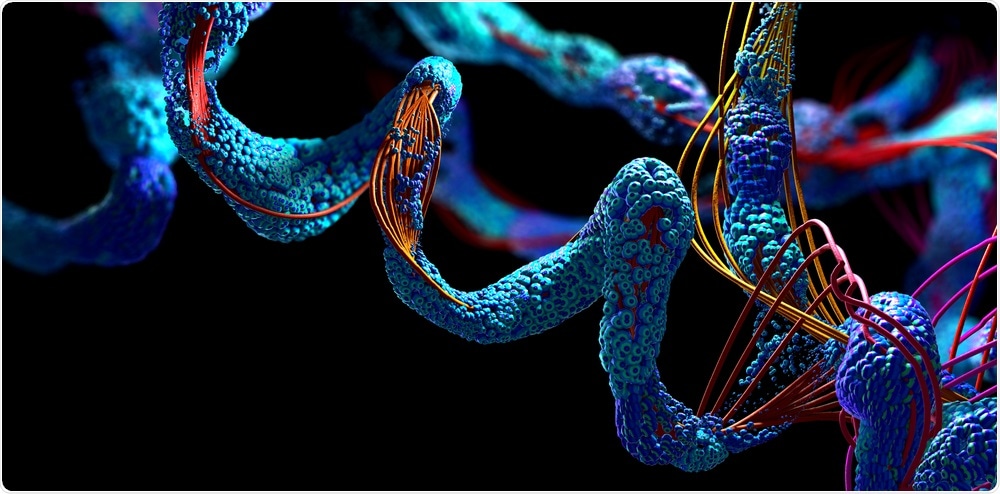Traditionally, it has always been assumed that the presence of water controls the way proteins fold. But a new study has challenged these details.

Image Credit: Christoph Burgstedt/Shutterstock.com
According to an article published in the American Chemical Society’s Journal of Physical Chemistry Letters, proteins that probably evolved to repel water while folding may, in fact, act in ways that were not expected by scientists.
These findings may change how investigators think about hydrophilic (water-attracting) and hydrophobic (water-repelling) interactions in solution, stated an engineer from Rice University.
Colleagues from Rice University, Tulane University, and the Johns Hopkins University School of Medicine developed atom-level models of polypeptides that demonstrated that folding is also controlled by thermal expansion of the solvents occupied by them, but not in ways that correspond with earlier assumptions.
According to Dilip Asthagiri, an associate research professor of chemical and biomolecular engineering at Brown School of Engineering of Rice University, the long-held assumption is that hydrophobic amino acids, which repel water by coming together as efficiently as possible, are a principal force in protein folding.
The latest study demonstrates that temperature—a factor which is hardly included in protein folding models—also controls the phenomenon. That should trigger a reevaluation of how proteins folding in a solution are stabilized, stated the team,
There are many proteins that are intrinsically disordered that don’t fold at all. One way the non-folding has been rationalized has been to look at the balance of hydrophobic groups and charged groups and, assuming the latter dominate, conclude the polypeptide does not fold.”
Dilip Asthagiri, Associate Research Professor, Department of Chemical and Biomolecular Engineering, Brown School of Engineering, Rice University
Asthagiri continued, “We showed in 2017 that in a model of an intrinsically disordered peptide that has no side chains, hydrophilic effects can in fact overwhelm the collapse driven by the still-substantial hydrophobic effects and drive the unfolding, even in the absence of charged residues. That study and the one published earlier in 2016 highlighted the role of hydrophilic effects. But we didn’t look at temperature effects.”
Therefore, the research team headed by Asthagiri began to model exactly how polypeptides, a classification comprising proteins in biological systems, unfold and fold as they make contact with water at different temperatures.
When the team computed the free energy of a sequence of hydrated deca-alanine peptides, together with its side-chains, they observed that forces of attraction between the peptide and solvent also play a key role, especially when more than one peptide is involved.
The researchers found that in the temperature ranges modeled by them, the solvent matrix around the polypeptides expands upon heating, reducing the number of solvent molecules that are around and makes contact with the peptides. This phenomenon can make the binding interactions between the peptides and solvent less favorable.
The team observed that the effect is insignificant for tiny molecules in a solvent, but increased in the case of larger proteins and peptides. They further stated the theory indicates that hydrophilic effects can play a role in the unfolding, or denaturation, of proteins in cold solutions.
The solution environment is an important contributor to the structure of proteins. Everything the solution does, including the water, has to do with how these proteins put themselves together and the functions they perform.”
Lawrence Pratt, Study Co-Corresponding Author and Chemical Engineer, Tulane University
Pratt is a longtime mentor to Asthagiri. He stated that hydrophobic effects in protein folding have been known since the 1940s.
It’s a rather tricky thing, though, because it has unusual temperature dependencies. You know, things live or die if you change the temperatures.”
Lawrence Pratt, Study Co-Corresponding Author and Tulane Chemical Engineer
Pratt continued, “Some hydrophobic effects get stronger when you raise the temperature, so things get to be more stable. But Dilip shows this increase in strength with increasing temperature can come from other places, including effects that all chemists would say are hydrophilic.”
“Both hydrophobic and hydrophilic effects come into play. And they’re competing, and they’re collaborating. And so being able to distinguish them individually in a very convincing way is a big step in sorting all this behavior out,” Pratt concluded.
Source:
Journal reference:
Tomar, D. S., et al. (2020) Hydrophilic Interactions Dominate the Inverse Temperature Dependence of Polypeptide Hydration Free Energies Attributed to Hydrophobicity. Journal of Physical Chemistry Letters. doi.org/10.1021/acs.jpclett.0c02972.